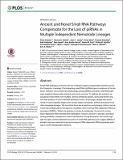Files in this item
Ancient and novel small RNA pathways compensate for the loss of piRNAs in multiple independent nematode lineages
Item metadata
| dc.contributor.author | Sarkies, Peter | |
| dc.contributor.author | Selkirk, Murray E. | |
| dc.contributor.author | Jones, John T. | |
| dc.contributor.author | Blok, Vivian | |
| dc.contributor.author | Boothby, Thomas | |
| dc.contributor.author | Goldstein, Bob | |
| dc.contributor.author | Hanelt, Ben | |
| dc.contributor.author | Ardila-Garcia, Alex | |
| dc.contributor.author | Fast, Naomi M. | |
| dc.contributor.author | Schiffer, Phillip M. | |
| dc.contributor.author | Kraus, Christopher | |
| dc.contributor.author | Taylor, Mark J. | |
| dc.contributor.author | Koutsovoulos, Georgios | |
| dc.contributor.author | Blaxter, Mark L. | |
| dc.contributor.author | Miska, Eric A. | |
| dc.date.accessioned | 2015-08-24T15:40:01Z | |
| dc.date.available | 2015-08-24T15:40:01Z | |
| dc.date.issued | 2015-02-10 | |
| dc.identifier | 208027220 | |
| dc.identifier | 28d3e89b-0ecc-409f-ae08-93d647634e79 | |
| dc.identifier | 000352080100008 | |
| dc.identifier | 84924024775 | |
| dc.identifier.citation | Sarkies , P , Selkirk , M E , Jones , J T , Blok , V , Boothby , T , Goldstein , B , Hanelt , B , Ardila-Garcia , A , Fast , N M , Schiffer , P M , Kraus , C , Taylor , M J , Koutsovoulos , G , Blaxter , M L & Miska , E A 2015 , ' Ancient and novel small RNA pathways compensate for the loss of piRNAs in multiple independent nematode lineages ' , PLoS Biology , vol. 13 , no. 2 , e1002061 . https://doi.org/10.1371/journal.pbio.1002061 | en |
| dc.identifier.issn | 1545-7885 | |
| dc.identifier.uri | https://hdl.handle.net/10023/7320 | |
| dc.description | Date of Acceptance: 02/01/2015 | en |
| dc.description.abstract | Small RNA pathways act at the front line of defence against transposable elements across the Eukaryota. In animals, Piwi interacting small RNAs (piRNAs) are a crucial arm of this defence. However, the evolutionary relationships among piRNAs and other small RNA pathways targeting transposable elements are poorly resolved. To address this question we sequenced small RNAs from multiple, diverse nematode species, producing the first phylum-wide analysis of how small RNA pathways evolve. Surprisingly, despite their prominence in Caenorhabditis elegans and closely related nematodes, piRNAs are absent in all other nematode lineages. We found that there are at least two evolutionarily distinct mechanisms that compensate for the absence of piRNAs, both involving RNA-dependent RNA polymerases (RdRPs). Whilst one pathway is unique to nematodes, the second involves Dicer-dependent RNA-directed DNA methylation, hitherto unknown in animals, and bears striking similarity to transposon-control mechanisms in fungi and plants. Our results highlight the rapid, context-dependent evolution of small RNA pathways and suggest piRNAs in animals may have replaced an ancient eukaryotic RNA-dependent RNA polymerase pathway to control transposable elements. | |
| dc.format.extent | 20 | |
| dc.format.extent | 1621042 | |
| dc.language.iso | eng | |
| dc.relation.ispartof | PLoS Biology | en |
| dc.subject | C-elegans | en |
| dc.subject | Caenorhabditis-elegans | en |
| dc.subject | Functional diversification | en |
| dc.subject | Processing center | en |
| dc.subject | DNA methylation | en |
| dc.subject | QH301 Biology | en |
| dc.subject.lcc | QH301 | en |
| dc.title | Ancient and novel small RNA pathways compensate for the loss of piRNAs in multiple independent nematode lineages | en |
| dc.type | Journal article | en |
| dc.contributor.institution | University of St Andrews. School of Biology | en |
| dc.contributor.institution | University of St Andrews. Biomedical Sciences Research Complex | en |
| dc.identifier.doi | https://doi.org/10.1371/journal.pbio.1002061 | |
| dc.description.status | Peer reviewed | en |
This item appears in the following Collection(s)
Items in the St Andrews Research Repository are protected by copyright, with all rights reserved, unless otherwise indicated.

